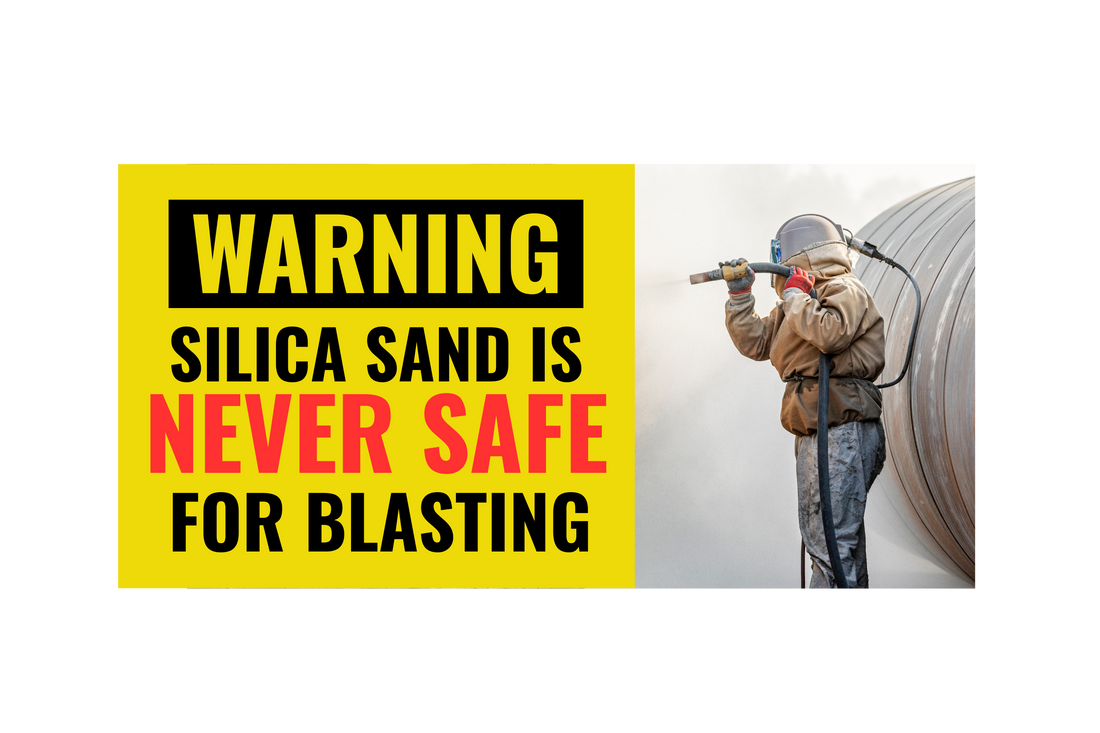The Hidden Dangers of Blasting with Silica Sand - Why You Should Never Use It
The Hidden Dangers of Blasting with Silica Sand — Why You Should Never Use It
Silica sand might look inexpensive, but blasting with crystalline silica (SiO2) is a severe health hazard. At blasting velocities, silica shatters into respirable dust that lodges deep in the lungs—driving silicosis, COPD, and lung cancer. Many countries ban silica sand for blasting, and U.S. rules place strict exposure limits. Bottom line: do not blast with silica sand.
WARNING: Crystalline silica is a Group 1 carcinogen. Even with a respirator, uncontrolled dust during blasting and cleanup can create dangerous exposures for operators, support crews, and bystanders.
Why Silica Sand Is So Hazardous in Blasting
- Fractures into respirable dust: High-energy impact pulverizes silica into particles small enough to penetrate deep lung tissue.
- Stays airborne: Fine silica lingers in air and resuspends during cleanup, increasing exposure risk well after blasting stops.
- Known carcinogen: Crystalline silica is classified worldwide as a Group 1 carcinogen.
- PPE has limits: Respirators help, but they don’t control fugitive dust in the environment or take-home contamination on clothing.
Silicosis Types & Onset
- Acute: Weeks to a few years at very high exposure; severe breathlessness, fever, fatigue.
- Accelerated: 5–10 years at high exposure; faster progression.
- Chronic: 10+ years at lower exposure; may progress even after exposure ends.
Symptoms & Secondhand Exposure
Persistent cough, shortness of breath, chest tightness, fatigue, and higher risk of infections (e.g., tuberculosis). Silica dust on clothing and tools can leave the jobsite—another reason blasting with silica is never acceptable.
Regulatory Reality
U.S. employers must comply with OSHA’s respirable crystalline silica standards (29 CFR 1926.1153 & 1910.1053): strict exposure limits, engineering controls, written plans, medical surveillance, and training. NIOSH recommends keeping exposures as low as reasonably achievable. Many countries ban silica sand as a blasting media outright.
Silica Sand vs. Safer Abrasives (At a Glance)
| Media | Health/Compliance | Jobsite Impact |
|---|---|---|
| Silica sand | Group 1 carcinogen; high risk of silicosis; regulatory violations likely | Heavy dust, take-home exposure, potential shutdowns |
| Garnet / Crushed Glass / Aluminum Oxide / Steel Grit | Silica-free alternatives with lower hazard profiles | Cleaner, more productive containment; better compliance |
Safer Alternatives You Can Use Today
- Garnet — low dust, efficient cutting, recyclable.
- Crushed glass — silica-free, great on many substrates.
- Aluminum oxide — durable, reusable, reclaim-friendly.
- Steel grit & shot — highly recyclable on large, contained jobs.
- Wet/vapor blasting — further reduces airborne dust.
Controls That Protect Your Crew
- Media selection: Use non-silica abrasives only.
- Containment & ventilation: Dust collectors and negative-pressure containment to capture fines.
- Recycling systems: Reduce media breakage and dust on high-volume jobs.
- PPE & hygiene: Supplied-air blast hoods, decon protocols, and no dry sweeping—use wet methods or HEPA vacs.
- Training & monitoring: Written exposure plan, exposure assessments, medical surveillance where required.
Note: This article is informational and not a substitute for current regulatory requirements. Always consult OSHA/NIOSH guidance and your site-specific safety plan.

